This post may contain affiliate links. Please read my privacy policy.
KL Hokkien Mee is one of my favorite Malaysian noodle dishes. Thick, chewy noodles are coated in a rich, dark soy sauce, packed with tender pork, juicy shrimp, crunchy cabbage, and crispy fried lard. It’s so simple to make at home, and the flavors are just as good as the best street food stalls in KL, Malaysia.
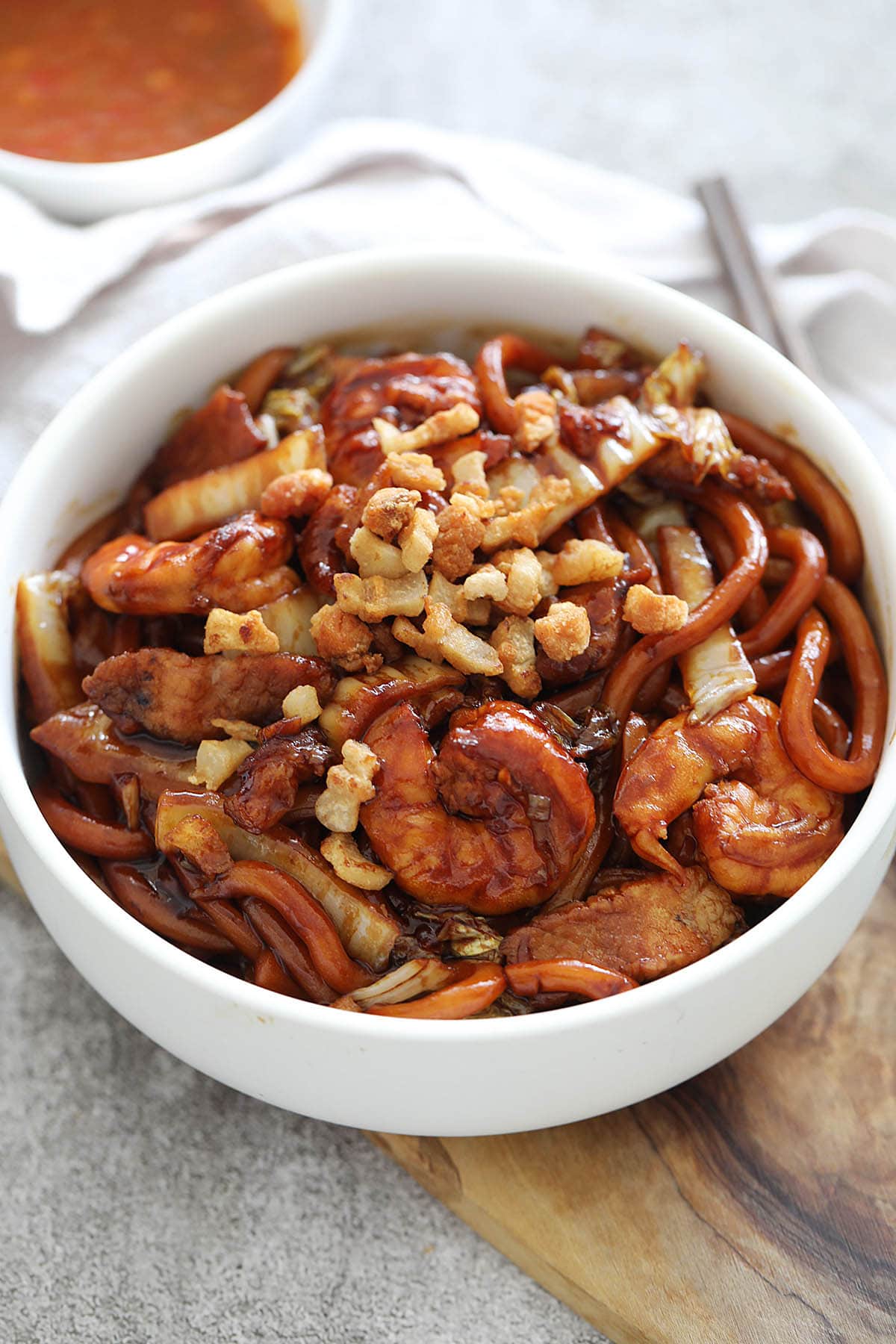
Authentic KL Hokkien Mee Recipe
KL Hokkien Mee is the perfect way to bring the vibrant flavors of Kuala Lumpur’s food scene right into your kitchen. Thick, chewy noodles are stir-fried with pork, shrimp, and a rich dark soy sauce, creating a smoky, deeply satisfying flavor. Finished with crispy pork lard and served alongside spicy sambal, it’s no surprise this dish is a street food favorite in KL.
If you’ve been to KL or call it home, you’ll love how this recipe captures everything that makes KL Hokkien Mee so special. From the iconic smoky aroma to the signature dark brown sauce, every bite is a delicious balance of tender pork, juicy prawns, and crispy lard. The homemade sambal adds just the right amount of heat to round it all out. With simple steps and plenty of tips, you can easily recreate this easy Hokkien Mee recipe at home—whether you’re missing the flavors of KL or just craving something comforting and delicious.
Check out my step-by-step video on how to make Hokkien Mee at home and tips to achieve that perfect wok-charred flavor and glossy sauce. It’s the ultimate guide to recreating this street food classic right in your own kitchen!
Looking for more delicious Malaysian noodle recipes? Check out my Wonton Noodles next!
Different Types Of Hokkien Mee
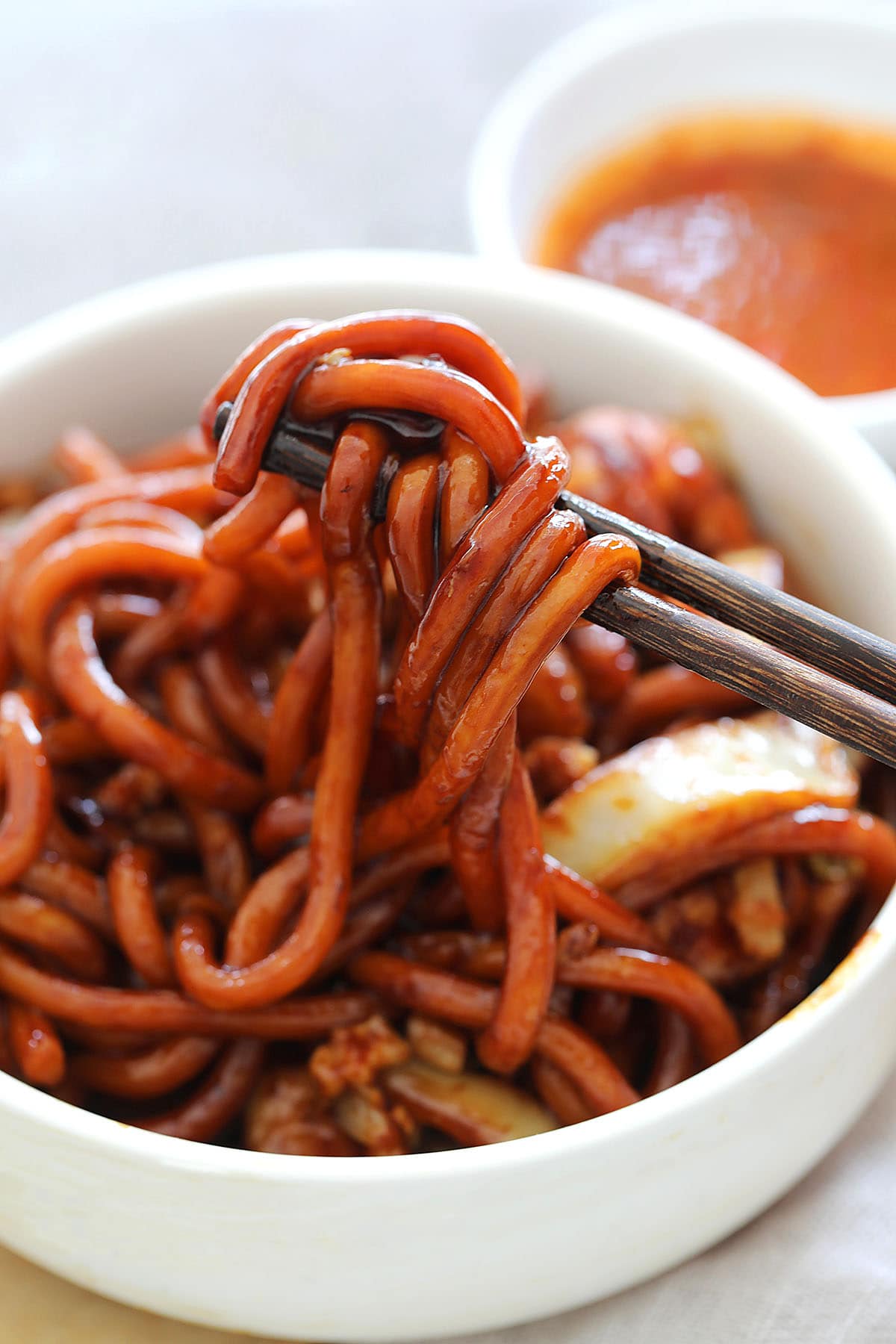
Hokkien Mee is a favorite noodle dish in Malaysia and Singapore, but each region has its own delicious twist. Here’s how they differ:
KL Hokkien Mee: This Kuala Lumpur favorite is all about bold, smoky flavors. Thick, chewy noodles are coated in a rich, dark soy sauce and topped with crispy pork lard for extra crunch. Don’t forget the sambal on the side—it takes the flavors to the next level!
Singapore Hokkien Mee: Lighter but just as tasty, the Singaporean version is stir-fried in a fragrant broth made from prawn shells and pork bones. With prawns, squid, and pork mixed in, it’s a milder take but still full of flavor.
Penang Hokkien Mee: This one’s my ultimate favorite. The star here is the spicy, flavorful prawn broth—it’s pure comfort in a bowl. Thinner noodles are paired with juicy prawns, pork, and a hard-boiled egg for a dish I can never resist.
Each version brings something unique to the table, but they’re all incredibly satisfying. If you love noodles as much as I do, you’ve got to try them all!
Secret Ingredient
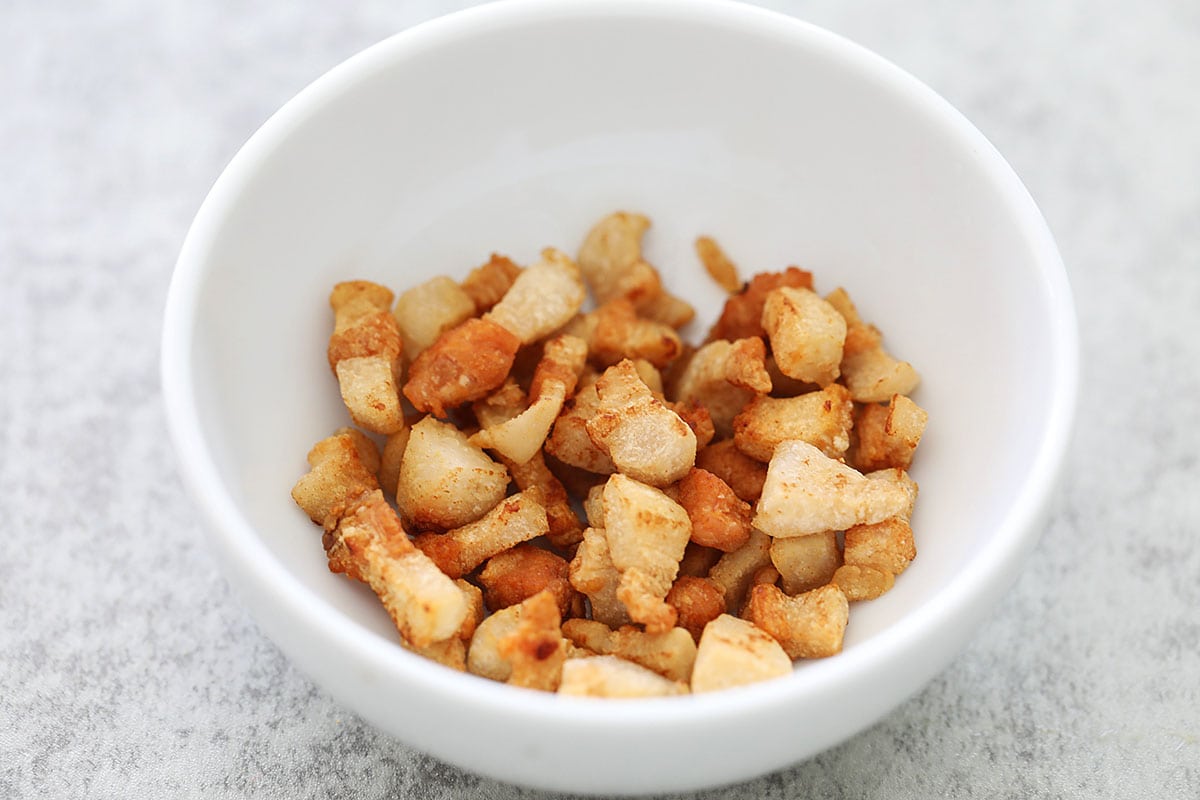
The secret to an authentic Hokkien Mee? It’s all about that pork fat, which I always get from my butcher. If you can’t find pork fat, no worries—just ask for a piece of pork belly with a good layer of fat on top. It works like a charm and gives the dish that rich, authentic flavor!
Sidenote: Pork fat and pork lard are similar but not identical. Pork fat is the raw fat from a pig, while pork lard is fat that has been fried and strained. Lard is often used for its rich flavor. For KL Hokkien Mee, pork lard adds an incredible depth of flavor to the noodle dish, making it absolutely irresistible!
Ingredients You’ll Need
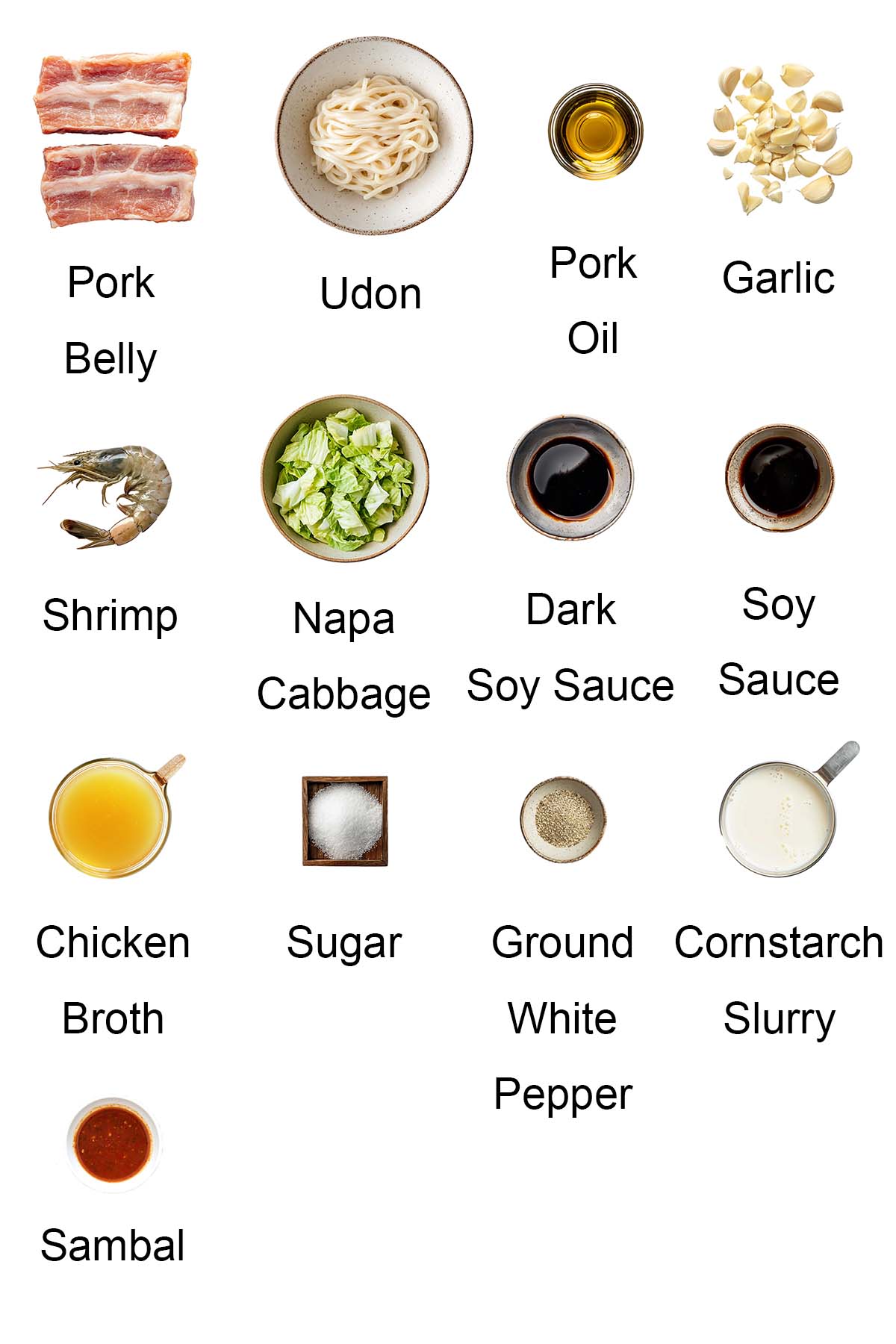
- Pork belly – Choose pork belly with a good balance of meat and fat layers. The meat should be pinkish-red in color, and the fat creamy white and firm. Avoid cuts with too much fat or very thin meat.
- Thick Hokkien noodles or udon – Hokkien mee calls for a thick Chinese noodles with a chewy texture. Udon is a great substitute for this recipe.
- Garlic
- Shrimp
- Napa cabbage
- Dark soy sauce – Gives the dish its glossy, deep, and rich signature color.
- Soy sauce
- Pork stock or chicken broth – The base of the dark sauce.
- Sugar
- White pepper
- Cornstarch slurry – Used to thicken the sauce, making it rich and glossy so it evenly coats the noodles.
- Sambal (for serving) – Adds a spicy, tangy kick on the side to complement the savory richness of the noodles.
Shopping Guide: You can find the thick Hokkien noodles at Asian grocery stores, typically in the refrigerated or frozen section. If you can’t find Hokkien noodles, you can also use similar Chinese noodles like Shanghai noodles or Japanese udon noodles as a substitute, as long as the texture is chewy. I don’t recommend regular yellow Hokkien noodles, you’re not making Penang Hokkien Char.
Please refer to the recipe card at the bottom of this post for full details on each ingredient.
How To Make KL Hokkien Mee
I’ve simplified this Hokkien Mee recipe to rival the best and most authentic versions you’ll find in KL. The result? Glossy, slurp-worthy, chewy noodles coated in a rich, thick dark sauce. Let’s get cooking!
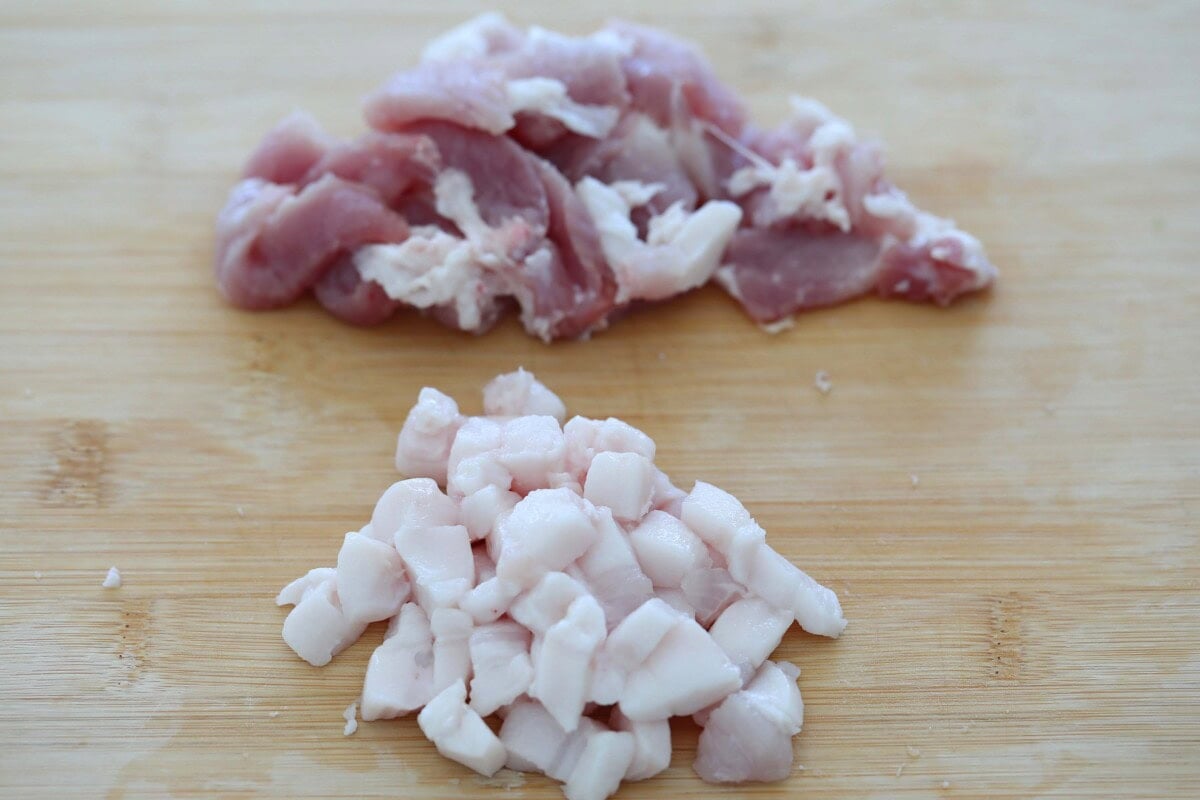
First, cut off and toss the skin from the pork belly. Cut away the fat from the meat, then chop the fat into small cubes or lardons. Slice the meat nice and thin, and set both aside for now.
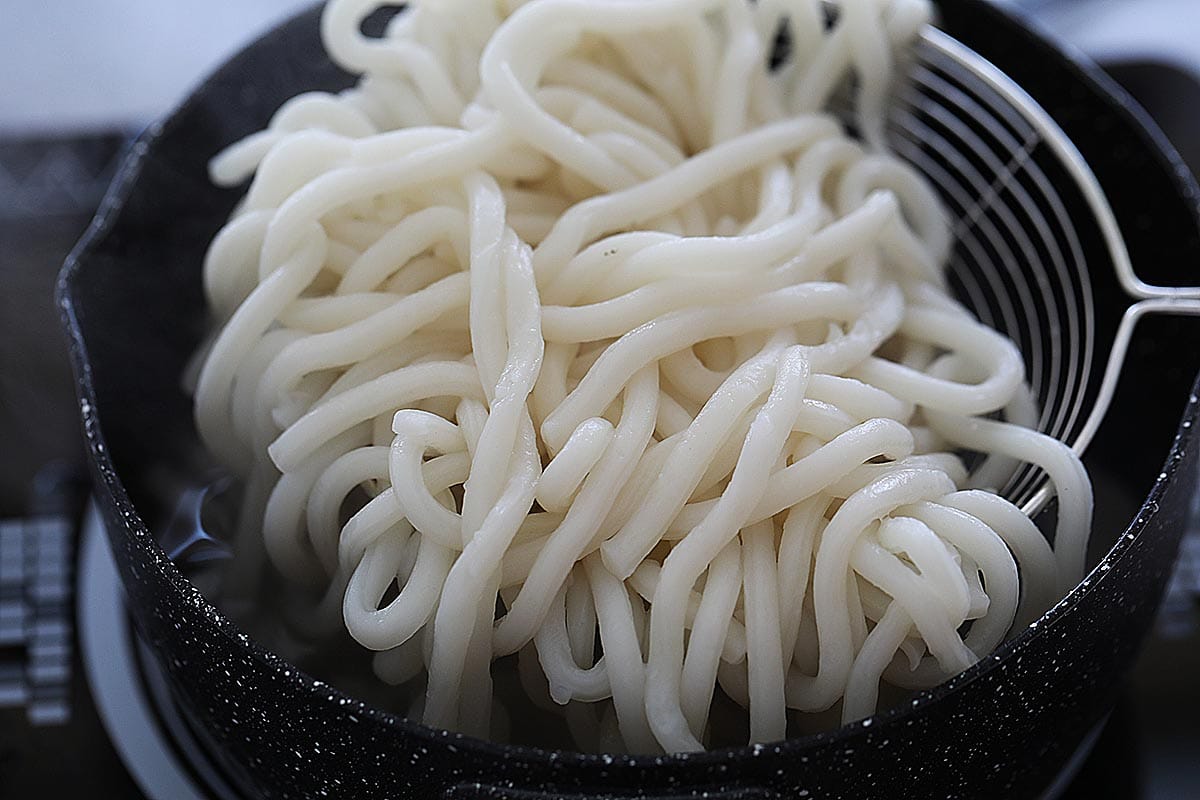
For this recipe, I used packet udon noodles. Just cook them according to the package instructions, drain well, and set them aside.
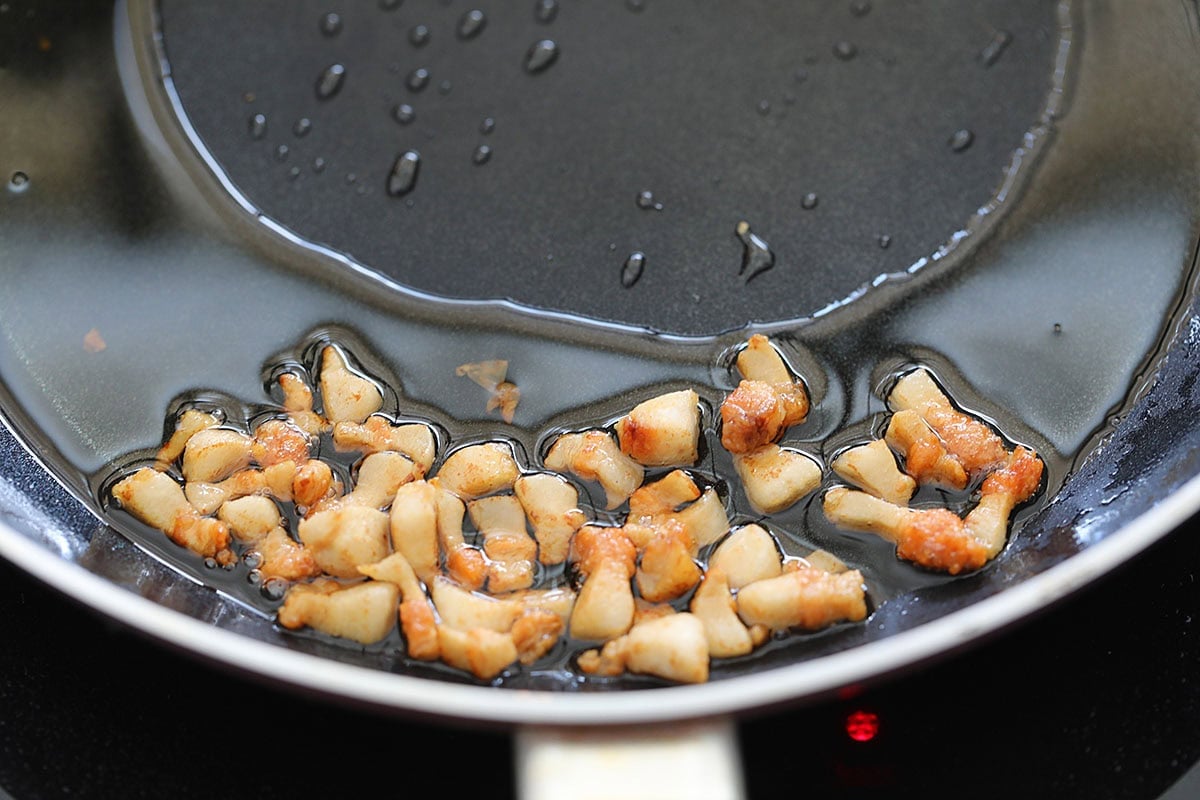
The key step: render pork fat into crispy lard. Cook diced pork fat in a medium-hot skillet until golden and crispy. Scoop out the chu yau cha and keep the pork oil—it’s liquid gold!
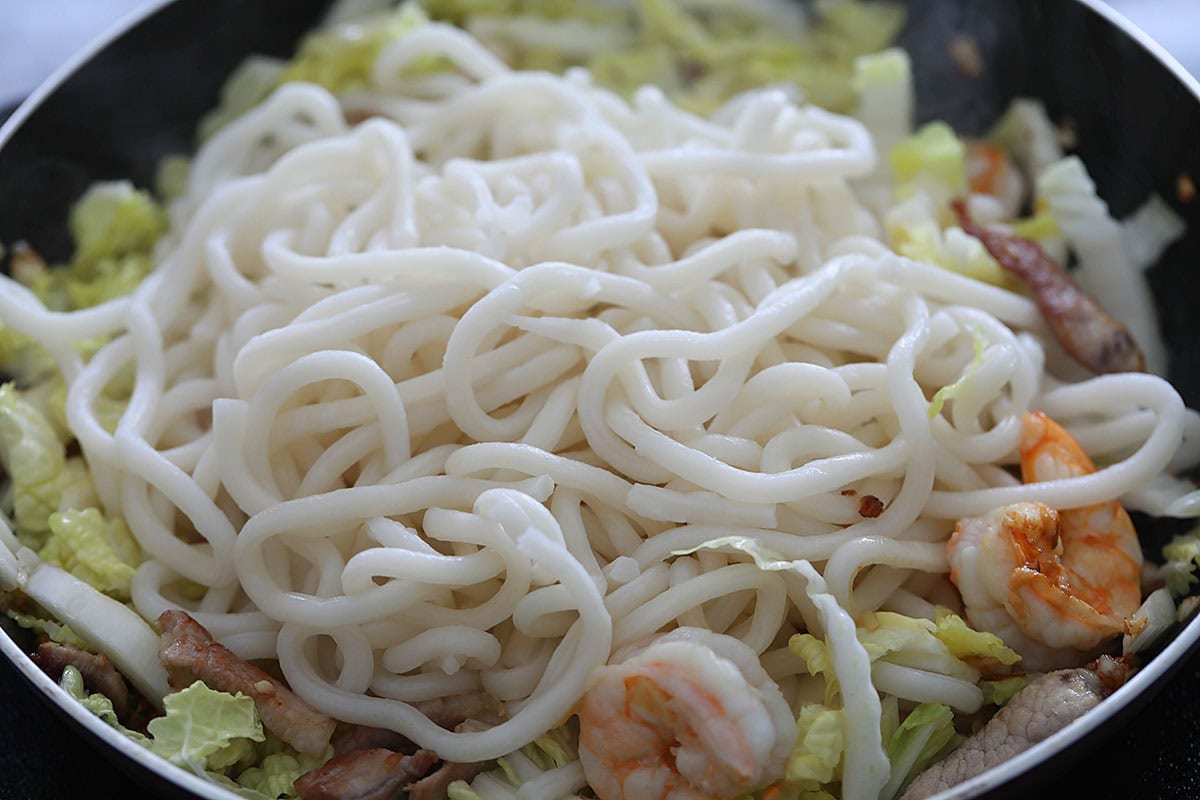
Throw the pork into the skillet and let it brown up nicely. Add the garlic and shrimp, add the Napa cabbage for a quick sizzle. Finally, throw in the noodles and give everything a good toss like you mean it!
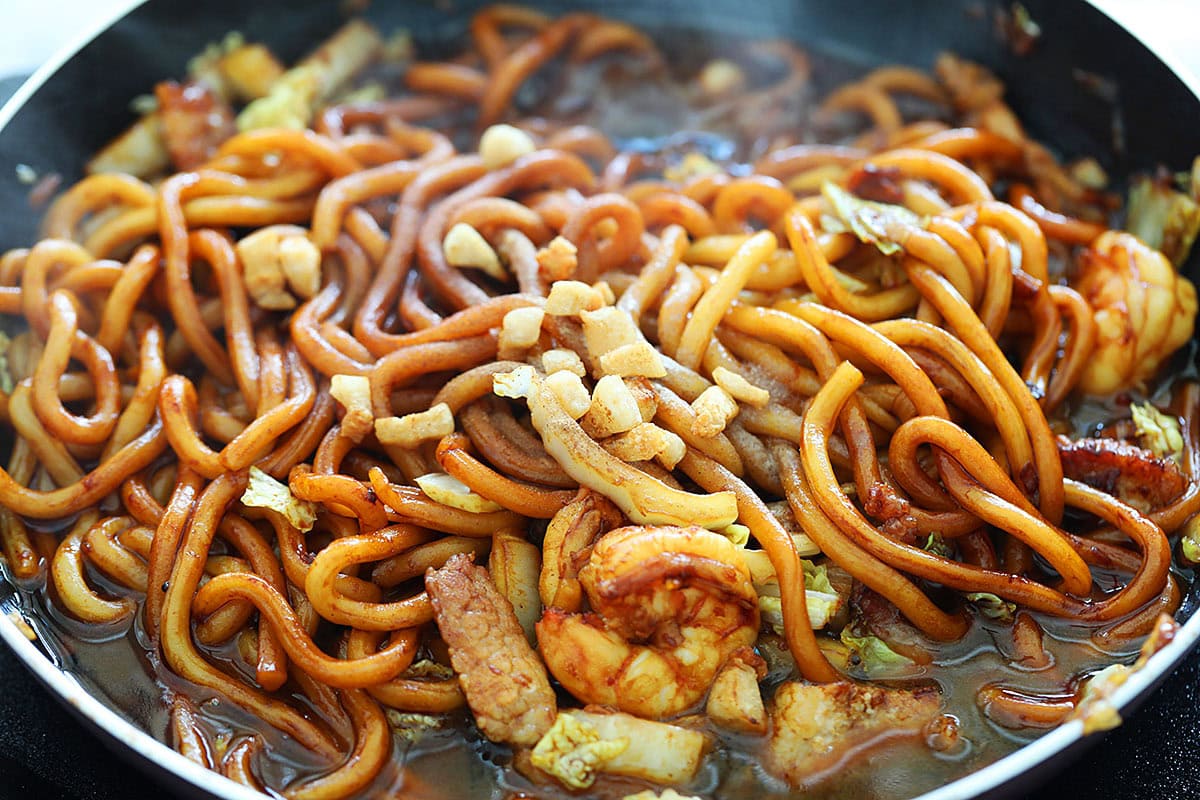
We’re almost there: stir in dark soy sauce, soy sauce, pork stock (or chicken broth), sugar, white pepper, and half the pork lard, then taste and adjust the seasoning. Finally, thicken the sauce with cornstarch slurry to coat the noodles perfectly.
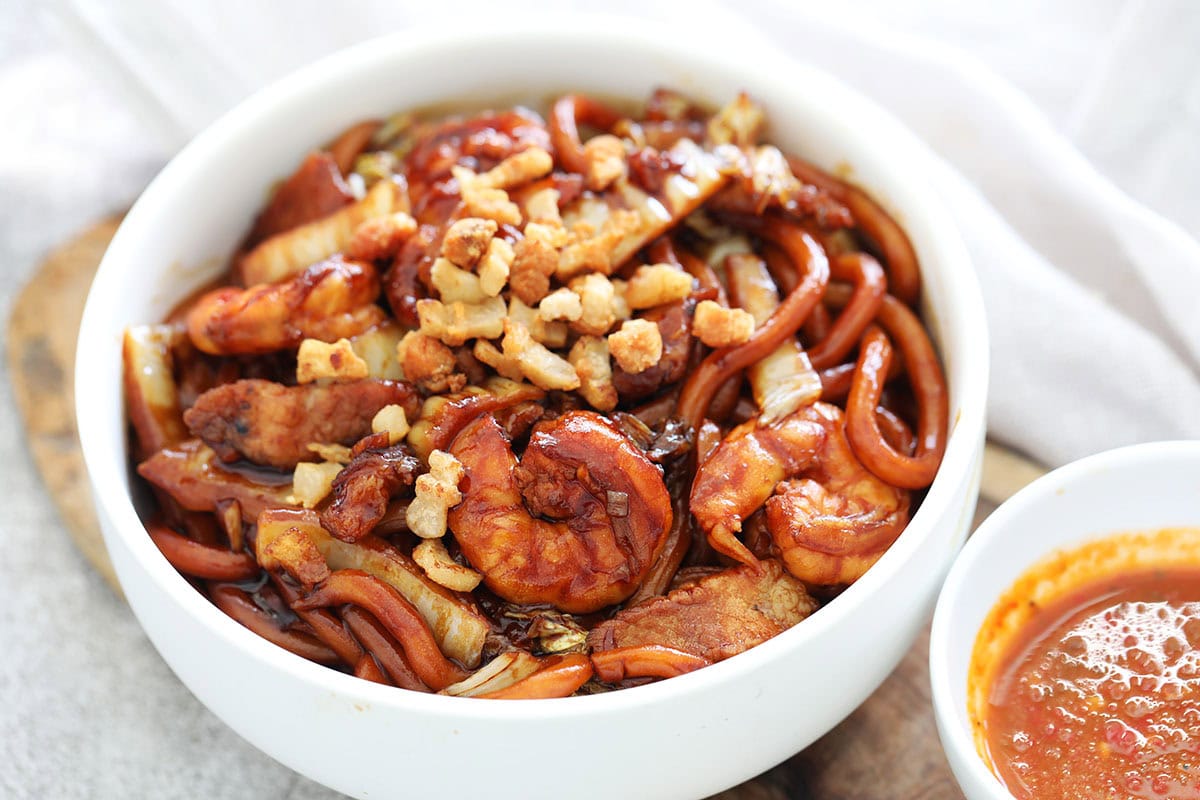
Serve the noodles, topping them with the remaining pork lard. Pair your KL Hokkien Mee with sambal (either sambal belacan or cooked sambal) on the side for an extra kick
Secrets To Perfecting KL Hokkien Mee
- I never skip the pork lard—it’s crucial for giving the dish that crispy texture and rich, indulgent flavor. It’s one of the key ingredients that really makes this dish stand out.
- I always stir-fry everything over high heat to get that wok-charred, smoky flavor that’s so signature to KL Hokkien Mee. It’s what makes every bite special.
- Dark soy sauce isn’t just for flavor; it also gives the dish its glossy, deep color. I adjust the amount to get that perfect look—just enough to make it shine.
- Once the noodles go in, I toss everything quickly. This helps them absorb the sauce evenly without getting soggy. It’s all about moving fast to keep that perfect balance of flavors and texture.
Frequently Asked Questions
The dish itself isn’t very spicy, but the sambal served on the side can be adjusted to your heat tolerance. If you prefer a milder version, you can use less sambal or leave it off entirely.
You can leave out the shrimp if you prefer or if you have dietary restrictions. You can replace it with more pork, chicken, or even fried tofu for a vegetarian option.
It’s best enjoyed fresh, but you can prepare some ingredients in advance, like marinating the pork belly and making the pork lard.
Store leftovers in an airtight container in the fridge for up to 2 days. To reheat, stir-fry in a wok or skillet on high heat, adding a splash of stock to revive the flavor and texture.
This recipe is 709 calories per serving.
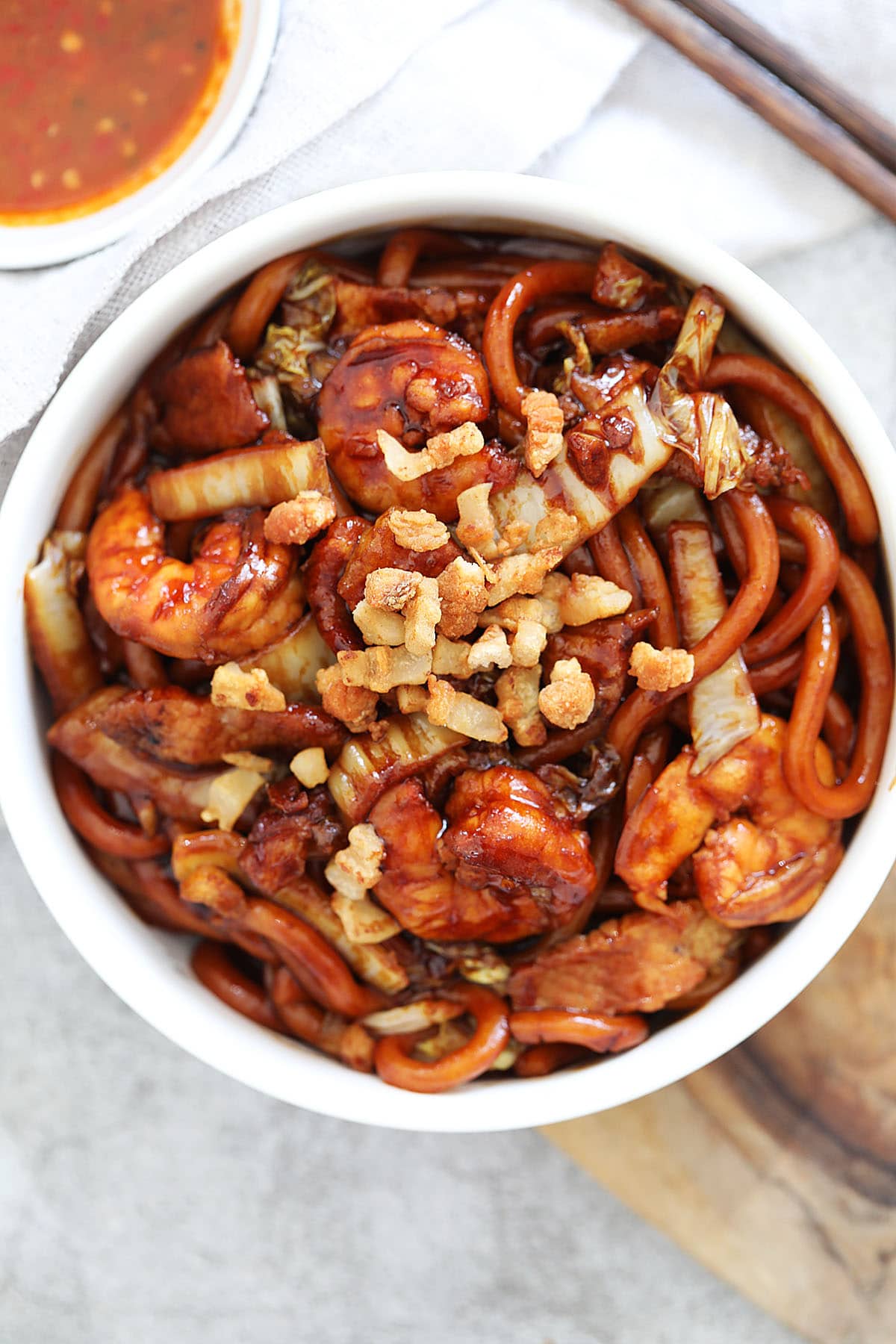
Other Popular Street Food Noodles
Here are a few popular Chinese noodles found in Malaysia:
I hope you enjoy this post as much as I do. If you try my recipe, please leave a comment and consider giving it a 5-star rating. For more easy and delicious recipes, explore my Recipe Index, and stay updated by subscribing to my newsletter and following me on Facebook, Pinterest, and Instagram for new updates.
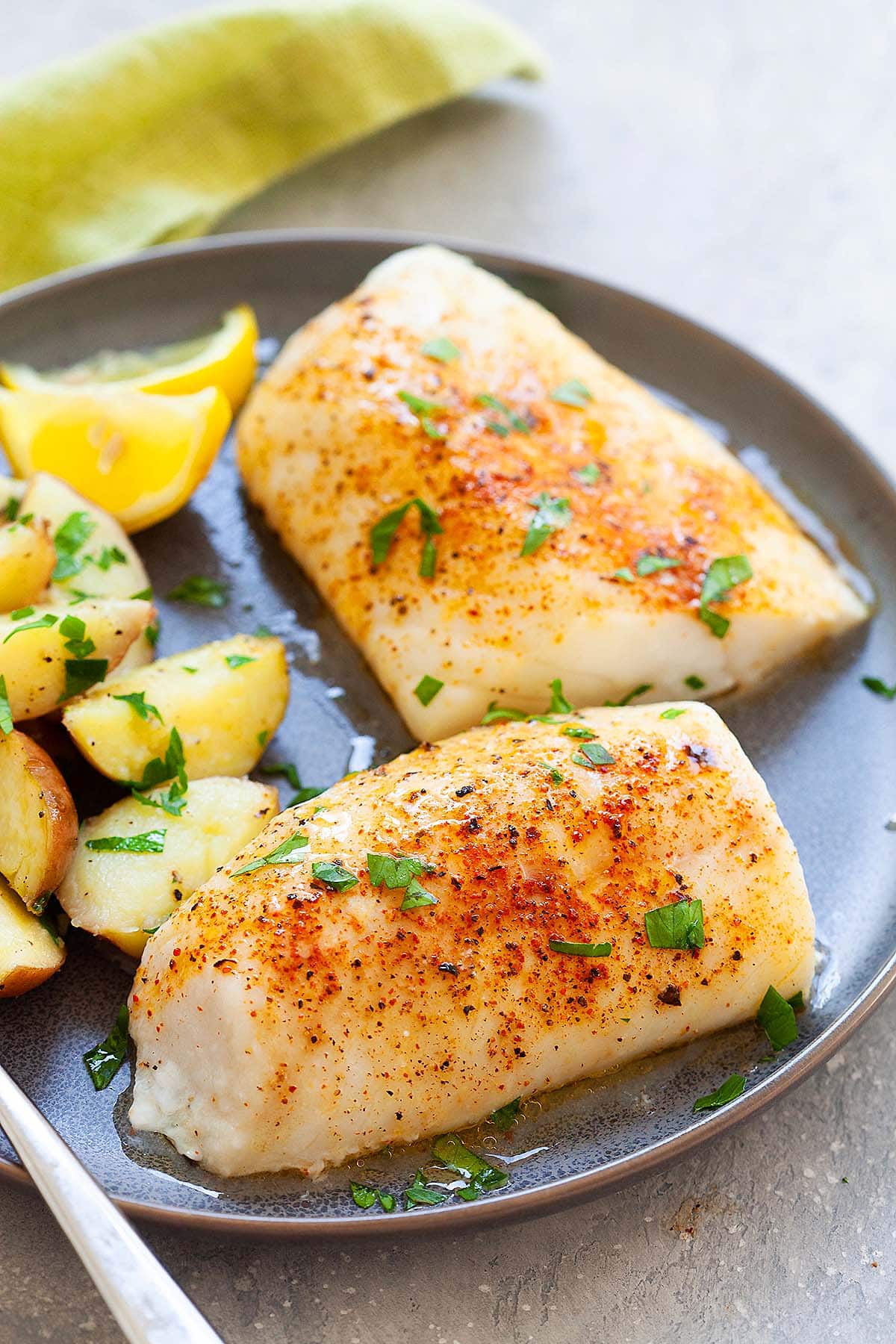
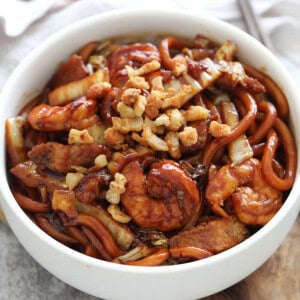
Hokkien Mee
Ingredients
- 170 g (6 oz) pork belly
- 400 g (14 oz) thick Hokkien noodles or Udon noodles, cook in boiling water or per package instructions
Other Ingredients:
- 3 tablespoons pork oil , recipe below
- 4 cloves garlic, minced
- 6 medium-sized shrimp, shelled, deveined and tails removed
- 2 cups packed sliced Napa cabbage
- 4 tablespoons dark soy sauce, I used Lee Kum Kee Cooking Caramel sauce
- 3 tablespoons soy sauce, or more to taste
- 3/4 cup pork stock or chicken broth
- 1 teaspoon sugar
- 3 dashes ground white pepper, to taste
- cornstarch slurry, mix 1 tablespoon cornstarch with 2 tablespoons water
- sambal, for serving
Instructions
- Remove and discard the skin from the pork belly. Separate the pork fat from the meat, then dice the pork fat into small cubes or lardons. Slice the meat into thin pieces and set both aside.
- If you are using fresh, thick Hokkien noodles, cook them in boiling water until al dente. If you are using udon, cook the noodles according to the package instructions. Drain and set aside.
Making Pork Lard and Pork Oil:
- Heat a wok or skillet over medium to high heat. Add the diced pork fat and cook until it becomes crispy and golden, rendering the fat into pork lard. Remove the crispy pork lard (chu yau cha) from the oil and drain it on paper towels. Set aside. Keep the pork oil in the wok or skillet.
Making KL Hokkien Mee:
- Add the pork pieces into the wok or skillet. Once the pork is just browned, add the garlic and shrimp, then stir-fry for about 30 seconds. Toss in the Napa cabbage and cook for another 10 seconds. Finally, add the noodles and give everything a quick toss.
- Add the dark soy sauce and soy sauce, stir and mix well to coat the noodles. Pour in the pork stock or chicken broth, sugar, white pepper, and half of the pork lard. Stir continuously to combine everything together. Taste the sauce and add more soy sauce and sugar to your preference. Add the cornstarch slurry to thicken the sauce so every strand of the noodles is coated in the dark sauce.
- Dish out the noodles and top with the remaining pork lard. Serve the KL Hokkien Noodles with sambal on the side.
Video
Notes
- I never skip the pork lard—it’s crucial for giving the dish that crispy texture and rich, indulgent flavor. It’s one of the key ingredients that really makes this dish stand out.
- I always stir-fry everything over high heat to get that wok-charred, smoky flavor that’s so signature to KL Hokkien Mee. It’s what makes every bite special.
- Dark soy sauce isn’t just for flavor; it also gives the dish its glossy, deep color. I adjust the amount to get that perfect look—just enough to make it shine.
- Once the noodles go in, I toss everything quickly. This helps them absorb the sauce evenly without getting soggy. It’s all about moving fast to keep that perfect balance of flavors and texture.
Nutrition
Nutrition information is automatically calculated, so should only be used as an approximation.
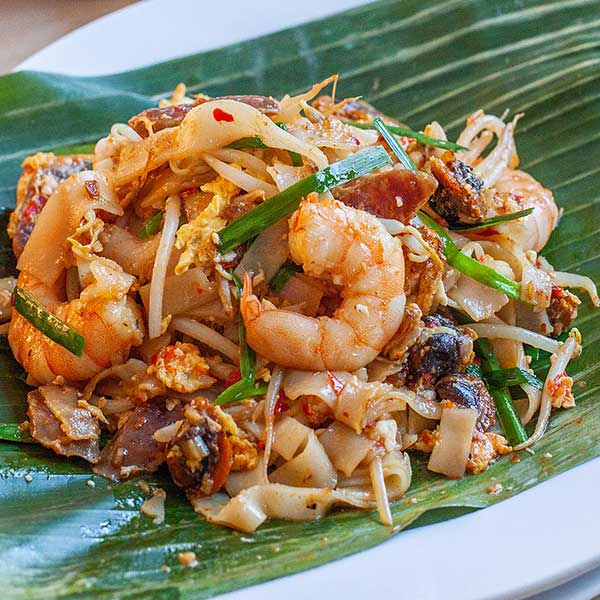
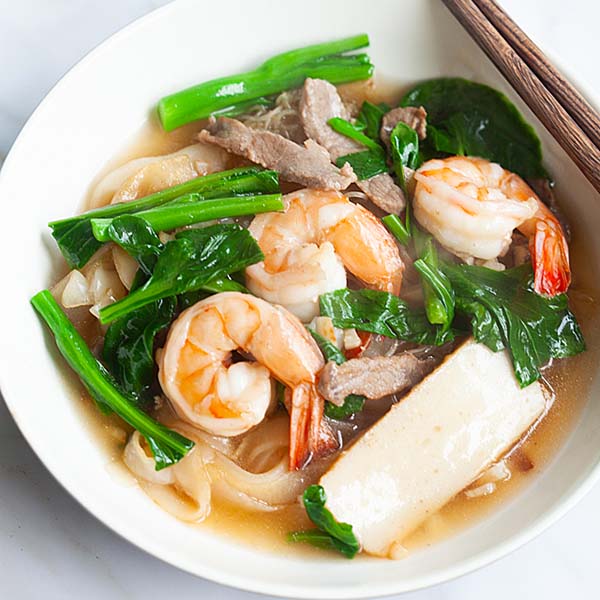
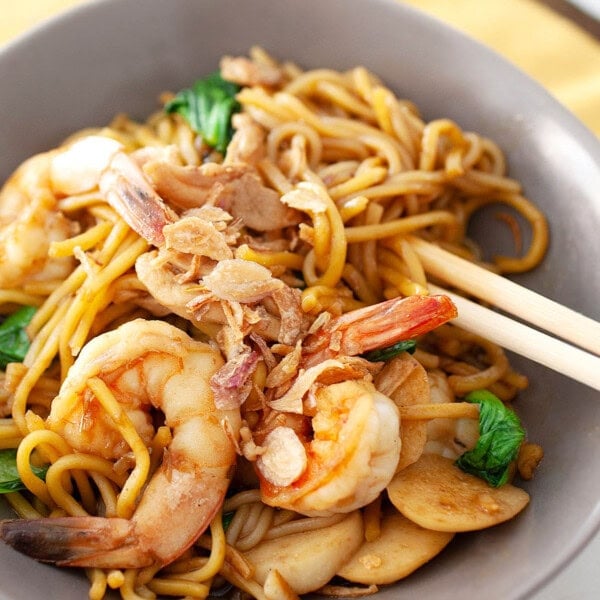
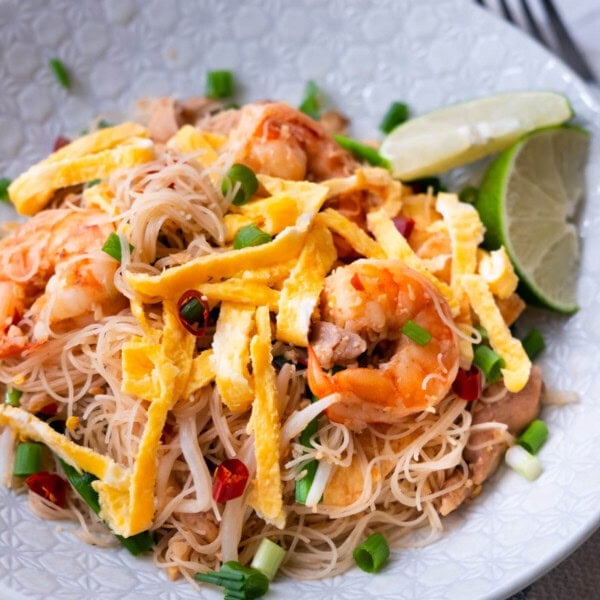






My brother told me, that the one thing he regrets, is not learning my late mum’s recipe for Hokkien mee. However, I am more than grateful, elated even, that I can ‘reclaim’ my mother’s recipe, by making my own with your beautiful guidance. Thank you so much, this means a lot more to me than you think. Thank you again.
Thanks Soo Ann!
Hi Bee,
Being a Malaysian, this is one of my favorite dishes. My late mom made really, really good Hokkien mee. All our neighbors raved about it. I was looking for this recipe since I never did learn from my Mom how to make it. Very unfortunate.
And your recipe struck me as the most authentic since you used pork lard. That was the secret ingredient. I made this tonight and my husband and I enjoyed except that it was a little too sweet. Next time, I would not add more sugar on top of the 4 tablespoons of dark soy sauce. Otherwise, I think your recipe is the closest to the real Hokkien mee. Thank you.
Thanks!
Hi Lucy,
I understand how you feel, as I have lost my mum before learning more from her…but isn’t it nice, that we can now make our own legacies? :) I would also like to thank you for the sugar suggestion, as my family’s palate is NOT pro-sugar…I might try adding some honey, and then checking the consistency of the thickness of the sauce! Thank you!